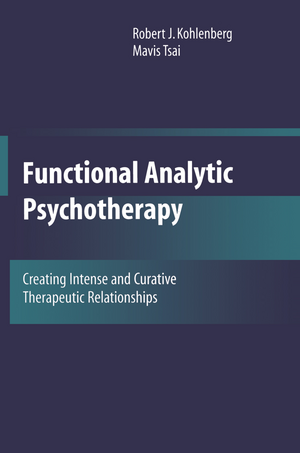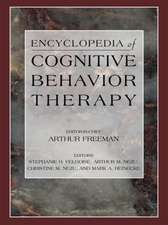Functional Analytic Psychotherapy: Creating Intense and Curative Therapeutic Relationships
Autor Robert J. Kohlenberg, Mavis Tsaien Limba Engleză Paperback – 26 iun 2007
The book begins with the theory behind the therapy (including its roots in B. F. Skinner’s behavior-analytic work in the 1970s), explaining why clients’ unique needs may extend beyond well-mapped routes to change. From there, the authors present the clinical principles of FAP and their uses in treating diffuse, resistant problems. Case illustrations model the therapeutic dyad, show FAP techniques in action, and offer crucial caveats. The ground rules: how, and why, FAP works. Recognizing clinically relevant verbal behaviors. The role of the self in personality disorders. New roles for cognitions and beliefs in therapy. Memories and emotions: what they can and can’t do to promote change. How FAP fills the niche between psychodynamic and behavioral therapy. Key issues in ethics, research, and supervision.
For the clinical psychologist interested in revitalizing practice, minimizing impasses, and treating clients on a deeper emotional level, Functional Analytic Psychotherapy brings fresh insights to the many worlds within and outside the clinical setting. Graduate students, especially, will find this text a valuable window onto traditional behavioral approaches to therapy.
Preț: 522.46 lei
Preț vechi: 549.96 lei
-5% Nou
Puncte Express: 784
Preț estimativ în valută:
99.98€ • 108.57$ • 83.99£
99.98€ • 108.57$ • 83.99£
Carte tipărită la comandă
Livrare economică 23 aprilie-07 mai
Preluare comenzi: 021 569.72.76
Specificații
ISBN-13: 9780387708546
ISBN-10: 0387708545
Pagini: 217
Ilustrații: XIV, 217 p.
Dimensiuni: 155 x 235 x 15 mm
Greutate: 0.32 kg
Ediția:1st ed. 1991. 2nd printing 2007
Editura: Springer Us
Colecția Springer
Locul publicării:New York, NY, United States
ISBN-10: 0387708545
Pagini: 217
Ilustrații: XIV, 217 p.
Dimensiuni: 155 x 235 x 15 mm
Greutate: 0.32 kg
Ediția:1st ed. 1991. 2nd printing 2007
Editura: Springer Us
Colecția Springer
Locul publicării:New York, NY, United States
Public țintă
Professional/practitionerCuprins
1Introduction.- Philosophical Tenets of Radical Behaviorism.- Theoretical Underpinnings of FAP.- 2Clinical Application of Functional Analytic Psychotherapy.- Client Problems and Clinically Relevant Behaviors.- Therapeutic Technique—The Five Rules.- Case Illustration.- 3Supplementation: Enhancing Therapist Awareness of Clinically Relevant Behavior.- Classification of Verbal Behavior.- Therapeutic Situations That Frequently Evoke Clinically Relevant Behavior.- 4The Role of Emotions and Memories in Behavior Change.- Emotions.- Memories.- Clinical Implications.- Case Illustration.- 5Cognitions and Beliefs.- Cognitive Therapy.- The FAP Revision of A ? B ? C.- Clinical Implications of the FAP View of Beliefs.- Case Illustration.- 6The Self.- Common Definitions of the Self.- A Behavioral Formulation of Self.- Maladaptive Development of the Self Experience.- Clinical Implications.- 7Functional Analytic Psychotherapy: A Bridge between Psychoanalysis and Behavior Therapy.- FAP in Contrast with Psychodynamic Approaches.- FAP in Contrast with Current Behavior Therapies.- FAP: A Unique Niche between Psychoanalysis and Behavior Therapy.- 8Reflections on Ethical, Supervisory, Research, and; Cultural Issues.- Ethical Issues.- FAP Supervision.- Research and Evaluation.- Cultural Problems Due to Loss of Contact.- Conclusion.- References.
Recenzii
From the reviews:
"This book describes how radical behaviorism can be used to create therapeutic relationships in order for meaningful change to occur. … The audience includes therapists ‘interested in revitalizing practice, minimizing impasses, and treating clients on a deeper emotional level.’ … graduate students will also find this book valuable. … is excellent in the way it combines two theories and shows specifically how to apply them in clinical work. … it is full of valuable information." (Gary B. Kaniuk, Doody’s Review Service, September, 2008)
"This book describes how radical behaviorism can be used to create therapeutic relationships in order for meaningful change to occur. … The audience includes therapists ‘interested in revitalizing practice, minimizing impasses, and treating clients on a deeper emotional level.’ … graduate students will also find this book valuable. … is excellent in the way it combines two theories and shows specifically how to apply them in clinical work. … it is full of valuable information." (Gary B. Kaniuk, Doody’s Review Service, September, 2008)
Notă biografică
Robert Kohlenberg, Ph.D., ABPP, is a professor of psychology at the University of Washington where he was the Director of Clinical Training from 1997 - 2004. The WA State Psychological Assoc. honored him with a Distinguished Psychology Award in 1999. He has presented "Master Clinician" and "World Round" sessions at the Association for the Advancement of Behavior Therapy and has published papers on migraine, OCD, depression, intimacy of the therapeutic relationship, and a FAP approach to understanding the self. He has presented FAP workshops both in the US and internationally. He has received research grants for FAP treatment development, and his current interests are identifying the elements of effective psychotherapy, the integration of psychotherapies, and the treatment of co-morbidity. He and Dr. Tsai are co-authors of Functional Analytic Psychotherapy: A guide for creating intense and curative therapeutic relationships. New York: Plenum. (1991).
Mavis Tsai, Ph.D., is a psychologist in independent practice and a clinical instructor at the University of Washington where she is involved in supervision and research. The list of publications and presentations by Dr. Tsai indicates the breadth of her expertise and includes work on healing PTSD interpersonal trauma with FAP, disorders of the self, power issues in marital therapy, incorporating Eastern wisdom into psychotherapy, racism and minority groups, teaching kids to be peace activists, and women's empowerment via reclaiming purpose and passion. She has led numerous workshops nationally and internationally and is known for her engaging interpersonal style as well as her behaviorally informed multi-modal approach to healing and growth that integrates mind, body, emotions, and spirit.
Mavis Tsai, Ph.D., is a psychologist in independent practice and a clinical instructor at the University of Washington where she is involved in supervision and research. The list of publications and presentations by Dr. Tsai indicates the breadth of her expertise and includes work on healing PTSD interpersonal trauma with FAP, disorders of the self, power issues in marital therapy, incorporating Eastern wisdom into psychotherapy, racism and minority groups, teaching kids to be peace activists, and women's empowerment via reclaiming purpose and passion. She has led numerous workshops nationally and internationally and is known for her engaging interpersonal style as well as her behaviorally informed multi-modal approach to healing and growth that integrates mind, body, emotions, and spirit.
Textul de pe ultima copertă
As cognitive behavior therapy becomes increasingly integrated, Functional Analytic Psychotherapy (FAP) remains a rich therapeutic method. FAP synthesizes aspects of psychodynamic and object relations therapy with traditional CBT methods, and author/ practitioners Robert Kohlenberg and Mavis Tsai originally created this book to be more than a simple how-to manual. Rather it is a powerful framework for clinicians seeking to rethink their approach to the therapeutic relationship. Now in paperback, this classic work is more relevant than ever.
The book begins with the theory behind the therapy (including its roots in B. F. Skinner’s behavior-analytic work in the 1970s), explaining why clients’ unique needs may extend beyond well-mapped routes to change. From there, the authors present the clinical principles of FAP and their uses in treating diffuse, resistant problems. Case illustrations model the therapeutic dyad, show FAP techniques in action, and offer crucial caveats.
The book begins with the theory behind the therapy (including its roots in B. F. Skinner’s behavior-analytic work in the 1970s), explaining why clients’ unique needs may extend beyond well-mapped routes to change. From there, the authors present the clinical principles of FAP and their uses in treating diffuse, resistant problems. Case illustrations model the therapeutic dyad, show FAP techniques in action, and offer crucial caveats.
- The ground rules: how, and why, FAP works.
- Recognizing clinically relevant verbal behaviors.
- The role of the self in personality disorders.
- New roles for cognitions and beliefs in therapy.
- Memories and emotions: what they can and can’t do to promote change.
- How FAP fills the niche between psychodynamic and behavioral therapy.
- Key issues in ethics, research, and supervision.
Caracteristici
Provides conceptual framework not isolated techniques Offers a psychotherapeutically useful version of radical behaviorism Contains ethical guidelines Covers borderline, narcissistic and multiple personality disorders











